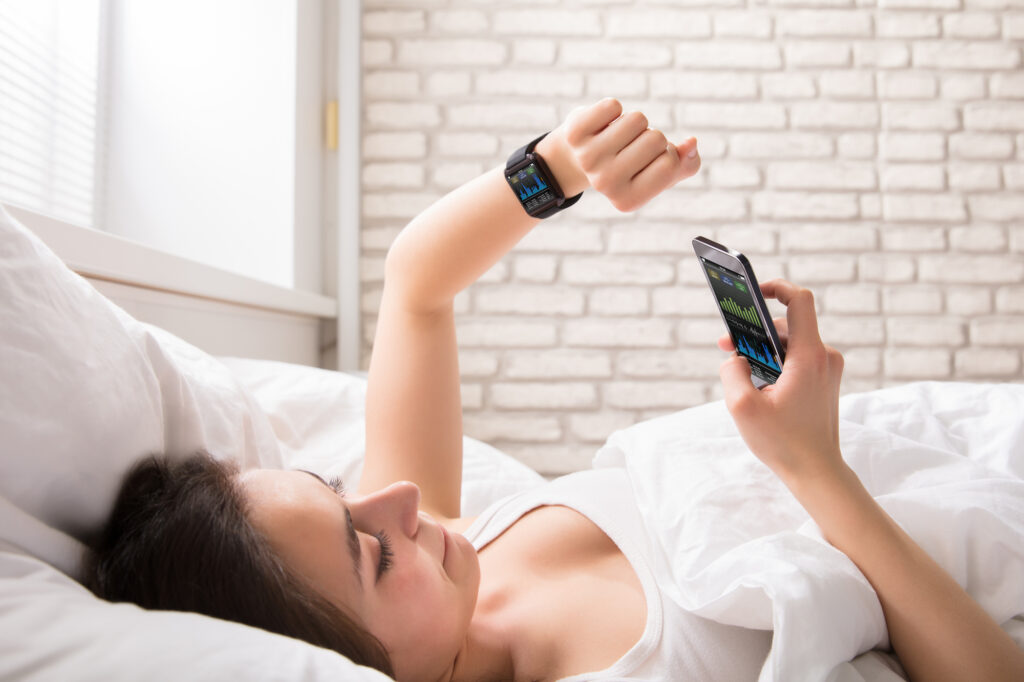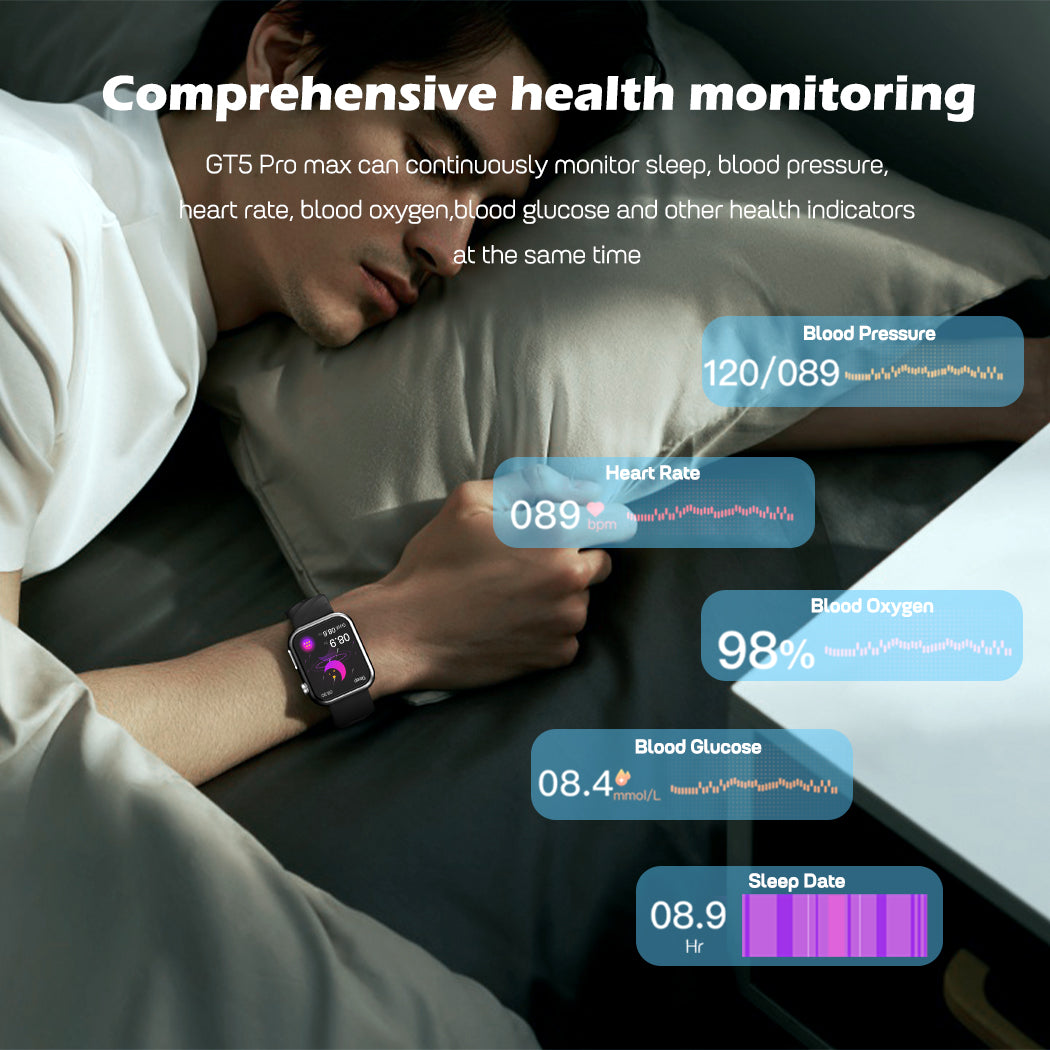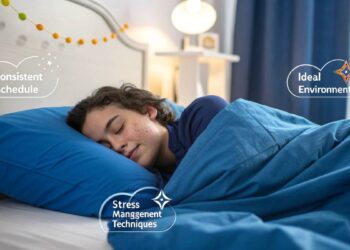Introduction
Struggling to wake up refreshed no matter how many hours you spend in bed? You’re not alone. In today’s non-stop world, restless nights and groggy mornings have become all too common. Enter sleep tracker watches—the high-tech solution promising not just dreams of better sleep, but actual, data-driven results. By turning your nightly rest into insightful stats, these wrist-bound sleep coaches unlock secrets about your patterns, reveal hidden triggers, and motivate you toward truly restorative slumber. Ready to reclaim your nights and power up your mornings? Let’s dive into how sleep tracker watches can help you finally get the zzz’s you deserve.
Key Takeaways
- Sleep tracker watches provide real-time insights into sleep stages, duration, heart rate, and wellness metrics.
- Leading devices include Whoop 4.0, Oura Ring Gen 4, and Fitbit Inspire 3—each with unique strengths for different needs.
- Tracking sleep is especially helpful for those with insomnia, offering actionable patterns and guidance.
- Features to prioritize: accuracy, battery life, and smart device compatibility.
- Using tracker data to adjust habits—like bedtime routines and stress management, improves overall sleep quality.
- The best device depends on individual lifestyle, preferences, and budget.
Overview of Sleep Tracker Watches
In today’s fast-paced world, where sleep-related issues are becoming increasingly common, sleep tracker watches have emerged as a game-changing solution. These innovative devices not only monitor sleep patterns but also provide insights into various health metrics that can guide users in their quest for better rest.
Sleep tracker watches transform data into actionable insights, offering a comprehensive overview of sleeping habits. Equipped with sensors that monitor movement, heart rate, and even oxygen levels, these devices assess sleep quality and duration. Most models connect to user-friendly apps, allowing individuals to review their sleep statistics and make informed adjustments to their routines.
“You can’t improve what you can’t measure. Sleep trackers illuminate your path to better rest.” – Dr. Michael Breus, Sleep Specialist
Here are the key features often found in advanced sleep tracker watches:
- Sleep Stages Monitoring: They can differentiate between light sleep, deep sleep, and REM sleep, offering a detailed breakdown.
- Heart Rate Variability: Many models provide data on heart rate and variability, essential indicators of overall health and stress levels.
- Activity Tracking: These devices commonly double as fitness trackers, providing valuable data on daily activity levels.
- Integration with Other Apps: Many sleep trackers sync with wellness and fitness apps, fostering a holistic approach to health.
With options like the Whoop 4.0, Oura Ring, and Google Pixel Watch, users can select a model that suits their lifestyle, whether they prioritize aesthetics, functionality, or the depth of data.
Importance of Sleep Tracking for Insomnia
For many, sleep doesn’t come easily. Insomnia, a condition characterized by difficulty falling or staying asleep, affects millions of people worldwide. In such cases, understanding one’s sleep patterns is crucial to finding solutions. Sleep tracker watches become invaluable tools for anyone grappling with insomnia.
“Technology like sleep trackers empowers chronic insomniacs to gain control—turning sleep from a mystery into a manageable routine.” – National Sleep Foundation
Personal experiences highlight the efficacy of these devices. For example, a user found that their stress levels were elevated during certain parts of the day, correlating with poor sleep quality at night. This realization empowered them to implement stress management techniques proactively, resulting in improved sleep hygiene.
Using a sleep tracker can help identify patterns and triggers that disrupt sleep. Here are some benefits of tracking sleep for insomnia sufferers:
- Awareness of Sleep Patterns: By monitoring sleep duration and quality, users can pinpoint patterns that impact their sleep cycles. A data-driven approach can also highlight how behaviors like caffeine consumption or irregular sleep schedules affect nightly rest.
- Personalized Insights: With detailed reports and graphs, users can identify how lifestyle choices directly affect their sleep quality. For instance, many users can track how their exercise routines or screen time influence their ability to fall asleep.
- Continuous Improvement: Tracking sleep offers the opportunity for ongoing refinement. By consistently reviewing sleep data, individuals can make small adjustments to their routines, fostering long-term improvements in sleep quality.
- Support for Professional Guidance: For those who consult health professionals, having a detailed sleep journal can provide doctors with valuable information. Sleep tracking data can facilitate informed discussions about sleep disorders, leading to tailored treatment plans.
In a world where stressors and distractions abound, utilizing technology for better sleep may be the solution many are seeking. Incorporating a sleep tracker watch not only serves as a motivational tool but also encourages personal accountability in the journey toward better sleep.
Introducing this technology into daily life may seem overwhelming; however, many users report feeling motivated by the data they collect. After weeks of tracking their patterns, they gain clarity on their sleep habits, leading to increased awareness and improved sleep hygiene.
Ultimately, sleep tracker watches serve as a beacon of hope for those seeking restful slumber, helping turn sleep from an elusive dream into a restorative experience.

Features to Consider
Accuracy of Sleep Tracking
When selecting a sleep tracker, accuracy is paramount. After all, the primary purpose of these devices is to provide insights into your sleeping patterns and overall health. Not all sleep trackers are created equal in this regard, and understanding the metrics they measure is crucial for getting useful data.
Most trackers utilize various sensors to collect data, and the best devices offer comprehensive sleep analysis, including:
- Sleep Stages: This feature breaks down your sleep into different stages, including light, deep, and REM sleep. Accurate identification of these stages is vital, as each serves a specific physiological function.
- Heart Rate Monitoring: Insights into your heart rate and variability can indicate your overall health and signal important changes related to stress or sleep disturbances.
- Movement Tracking: Many devices use motion sensors to determine if you’re asleep or awake, but errors can occur. Some may confuse periods of stillness for sleep, leading to inaccuracies.
- Advanced Metrics: Look for devices that measure metrics like blood oxygen levels and body temperature. These additional data points can provide a deeper understanding of how your health impacts sleep quality.
For example, when using the Whoop 4.0, I felt reassured by its advanced sleep metrics. The device provided not only a sleep score but also separated my total sleep time into stages, which helped me understand the effects of my daily activities on my rest.
While it’s important to have a good grasp of the accuracy of these trackers, keep in mind that even the best wearable technology cannot replace a professional sleep study. If you suspect serious sleep disorders like sleep apnea, consulting a healthcare provider is crucial.
Battery Life and Charging Options
Battery life is another important consideration for sleep trackers. After all, the last thing you want is to deal with a device that requires nightly charging or dies in the middle of the night.
Here are a few points to keep in mind regarding battery life and charging:
- Durability: Many top-rated devices, such as the Oura Ring, can last about a week on a single charge. On the other hand, some smartwatches, like the Apple Watch Series 10, may need to be charged daily, which can be inconvenient for sleep tracking.
- Charging Method: Consider how easy it is to charge your device. Some sleep trackers come with removable batteries that allow charging on the wrist, like the Whoop. Others, such as rings, might stay on while charging or require you to remove them completely.
- Usage Recommendation: Pay attention to how the device recommends using it. Some wearables advise you to wear them all day to gather comprehensive data, while others may only require nighttime use.
For example, my experience with the Garmin Forerunner 165 showed that it provided a solid battery life of about eight days, which meant I could comfortably wear it during my workouts and sleep without interruption.
Ultimately, the longer a device holds a charge, the less you’ll need to think about charging interruptions impacting your sleep tracking.
Compatibility with Devices
The functionality of your chosen sleep tracker can be significantly enhanced by its compatibility with other devices, so consider the following:
- Smartphone Compatibility: Check if the tracker syncs with your smartphone’s operating system, whether it’s iOS or Android. Some devices like the Oura Ring are compatible with both, while others might be limited, like the Galaxy Ring, which is designed primarily for Android users.
- App Ecosystem: A good sleep tracker should come with an intuitive app that provides accessible insights into your sleep data. For instance, Apple Watch users benefit from the Vitals app that gives a straightforward breakdown of sleep quality and bodily functions.
- Integration: Many advanced trackers, like the Whoop 4.0, can integrate with other health apps to provide a holistic view of your sleep and overall health using the data from different sources.
Throughout my journey with these devices, I found that compatibility played a significant role in how useful the data was. For example, I loved how the Oura Ring integrated seamlessly with my Apple Health app, giving me a comprehensive view of my activity, sleep, and overall wellness in one place.
In summary, the features of accuracy, battery life, and compatibility are essential factors to evaluate when choosing a sleep tracker. By prioritizing these aspects, you can ensure that your sleep tracker not only meets your expectations but also provides meaningful insights to help improve your sleep quality over time.

Top Sleep Tracker Watches for Insomnia
Sleep tracking devices can be a vital tool for anyone dealing with insomnia, offering insights that may lead to a better night’s sleep. In this section, we will explore some of the top sleep tracker watches available in 2025, breaking down their features, reviews, pros, and cons.
Brand A: Whoop 4.0
The Whoop 4.0 is celebrated as the best overall sleep tracker on the market. With a focus on in-depth health data and personalized insights, it’s a favorite among athletes and those serious about their health journeys.
Features:
- Comprehensive Sleep Analysis: Tracks sleep stages, heart-rate variability, and recovery metrics.
- Integration of Exercise Data: Adjusts sleep recommendations based on daily strain from workouts.
- AI Coaching: Offers personalized tips on when to sleep, mindfulness practices, and training recommendations.
- Battery Life: Lasts up to 5 days on a single charge.
As someone who values data, using the Whoop has been enlightening. I received instant feedback on how my workouts impacted my sleep quality, helping me make adjustments to improve my rest.
Pros:
- In-depth data and analysis.
- Offers personalized recommendations.
- Removable battery for charging on the wrist.
Cons:
- Pricey with a subscription model ($30/month).
- Bulky design that might not be comfortable for everyone to sleep with.
Brand B: Oura Ring Gen 4
The Oura Ring Gen 4 stands out as one of the best wearable sleep trackers. Its elegant, discreet design makes it an appealing choice for many users.
Features:
- Sleep Stage Tracking: Monitors light, deep, and REM sleep, along with sleep duration.
- Multiple Health Insights: Measures heart rate, body temperature, blood oxygen level, and activity.
- Daily Readiness Score: Helps gauge when your body is ready for physical activity.
- Battery Life: Lasts between 5-7 days on a single charge.
I’ve been using the Oura Ring, and it’s become an essential part of my daily routine. Each morning, I check my sleep score and reflect on the factors that contributed to it. It’s seamless to wear throughout the day, and I often forget I have it on!
Pros:
- Comfortable and lightweight design.
- Long battery life compared to many other wearables.
- Integrates well with health apps like Apple Health and Google Fit.
Cons:
- Requires a $6 monthly subscription for full functionality.
- Susceptible to scratches depending on the finger it’s worn on.
Brand C: Fitbit Inspire 3
The Fitbit Inspire 3 is frequently deemed the best tracker watch for those who seek a robust yet straightforward experience.
Features:
- Basic Sleep Tracking: Monitors sleep stages, heart rate, and overnight blood oxygen levels.
- Daily Stress Management Score: Guides users through mindfulness and stress-reducing activities.
- User-Friendly App: Provides detailed sleep and activity insights in an approachable format.
- Battery Life: Lasts up to 10 days on a full charge, which is impressive for a smartwatch.
On a casual day, I tested the Fitbit Inspire 3 simply by wearing it during my sleep. I appreciated how easily I could check my metrics the next day without any complicated setup.
Pros:
- Affordable price point at around $100.
- Long battery life ensures you can wear it day and night without frequent recharging.
- No subscription is required for basic features.
Cons:
- Limited advanced insights compared to pricier models.
- May require a subscription ($10/month for premium features) for access to advanced health metrics.
In conclusion, choosing the right sleep tracker depends largely on individual preferences and priorities. The Whoop 4.0 offers in-depth data and insights for those serious about fitness, while the Oura Ring provides a comfortable and stylish wear with valuable health metrics. For those just starting their sleep-tracking journey, the Fitbit Inspire 3 delivers credible results at a more approachable price point. Each of these devices can provide vital information in the fight against insomnia, helping users cultivate better sleep habits over time.

How Sleep Tracker Watches Help with Insomnia
Struggling with insomnia can feel overwhelming, but sleep tracker watches are innovative tools that can empower individuals on their path to better sleep. Let’s explore how these devices can assist people dealing with insomnia in tracking their sleep patterns, providing valuable insights, and integrating with sleep improvement techniques.
Tracking Sleep Patterns
The first step in addressing insomnia is understanding one’s sleep patterns, and sleep tracker watches are designed specifically for this purpose. These devices collect data on various sleep metrics that give users a clearer picture of their sleepless nights.
Some of the key metrics include:
- Total Sleep Duration: How long you actually sleep versus how long you spend in bed.
- Sleep Stages: The breakdown of light sleep, deep sleep, and REM sleep stages offers insights into sleep quality.
- Wake Events: Tracking how often you wake up during the night helps identify disruptions.
For example, when I first began using the Oura Ring, I noticed that my average sleep was around six hours with a significant amount of light sleep. This data made me realize that while I was in bed for long periods, I was not reaching deep or restorative sleep nearly enough. Armed with these insights, I could pinpoint areas for improvement.
Moreover, sleep tracker watches can even integrate with apps that visualize these patterns, making it easy to spot trends over time, such as sleep disruptions related to stress or late-night screen time.
Providing Insights for Better Sleep
Once users have established a baseline understanding of their sleep patterns, the next step is gaining actionable insights that can lead to sleep improvements. Many sleep tracker watches, such as the Whoop 4.0 or Fitbit Inspire 3, provide thoughtful analysis and personalized recommendations based on the collected data.
For instance:
- Daily Readiness Score: Devices like the Oura Ring generate a readiness score that assesses how well-prepared you are to tackle the day based on your previous night’s sleep and overall health.
- Personalized Recommendations: Many trackers suggest optimal bedtimes, lifestyle changes, or mindfulness exercises based on your sleep data. For instance, the Whoop app might recommend an earlier bedtime if it detects trends in poor sleep quality.
In my experience, after using the Fitbit Inspire 3, I started receiving helpful tips on how to manage stress leading up to bedtime. This targeted advice transformed my bedtime routine, making it easier to wind down without distractions—eventually translating into deeper, more restorative sleep.
Additionally, many apps connected to sleep trackers allow users to monitor correlations between sleep quality and daily habits. By inputting information around caffeine consumption or stressful events that occurred throughout the day, users can create a clearer picture of patterns affecting their insomnia.
Integrating with Sleep Improvement Techniques
Most importantly, sleep tracker watches can integrate with other sleep improvement techniques, providing a comprehensive approach to tackling insomnia. Incorporating data-driven insights, these devices can help users experiment with various strategies to enhance their sleep hygiene.
Some methods include:
- Establishing a Bedtime Routine: Set consistent sleep and wake times, guided by sleep tracker reminders.
- Incorporating Mindfulness or Meditation: Utilize app features that offer guided breathing exercises or meditation sessions aimed at relaxing the mind before sleep.
- Reducing Blue Light Exposure: Create alerts to remind you to limit screen time before bed, which can improve melatonin production and support healthier sleep.
For instance, I’ve utilized a guided meditation feature from the Oura app designed to help users relax before bedtime, and it has significantly improved my ability to fall asleep more quickly.
By staying consistent with my new habits and leveraging my tracker’s insights, I gradually transformed my sleep quality. This kind of data-driven approach has shown to empower individuals to take charge of their sleep, ultimately leading to a more fulfilling life.
In conclusion, sleep tracker watches serve as valuable allies for individuals struggling with insomnia. By effectively tracking sleep patterns, providing keen insights, and integrating with techniques for better sleep, these devices can foster a healthier relationship with sleep and improve overall well-being.

Tips for Using Sleep Tracker Watches Effectively
As you start your journey with sleep tracker watches, leveraging their capabilities can significantly enhance your sleep quality. Here are some essential tips for making the most out of these devices: from setting realistic sleep goals to establishing a bedtime routine and utilizing the data for improvement.
Setting Realistic Sleep Goals
One of the first steps in optimizing your sleep experience is to set realistic sleep goals based on data collected from your tracker. This process involves a few straightforward steps:
- Analyze Baseline Sleep Data: Start by reviewing your initial sleep data over the first few weeks. Identify how many hours of sleep you typically get, and understand your sleep quality based on the metrics your tracker provides.
- Understand Individual Needs: Everyone’s sleep requirements are unique. Most adults thrive on 7-9 hours of sleep, but factors like age and lifestyle can necessitate different amounts. Acknowledge your body’s needs and customize your goals accordingly.
- Create Short-Term and Long-Term Goals:
- Short-term: Focus on increasing sleep duration gradually. For example, if you currently average 5.5 hours, aim for 6.5 hours this week.
- Long-term: Set broader goals, like achieving consistent sleep schedules, indicating a commitment to improved sleep hygiene.
For personal context, I had been averaging only six hours of sleep and felt drained most mornings. Setting a realistic goal of achieving a solid 7 hours helped me focus on my nightly routines without feeling overwhelmed.
Establishing a Bedtime Routine
Creating a consistent bedtime routine can be pivotal in enhancing sleep quality. Here are some practical steps to establish an effective routine:
- Set a Consistent Sleep Schedule: Aim to go to bed and wake up at the same times every day—even on weekends. This practice reinforces your body’s internal clock, making it easier to fall asleep and wake up feeling refreshed.
- Dimming Lights and Limiting Electronics: About an hour before bedtime, lower the lights and put away electronics. Blue light emitted from phones and tablets can interfere with melatonin production, making it harder to fall asleep.
- Relaxation Techniques: Incorporate calming activities into your evening routine:
- Meditation or deep breathing exercises.
- Reading a book or listening to soothing music.
- Engaging in gentle stretches or practices like yoga can help transition your mind and body into sleep mode.
After I started implementing a wind-down period filled with calming music, I noticed a significant improvement in how quickly I was able to sleep.
- Avoid Stimulants: Keep an eye on substance intake. Steer clear of caffeine and nicotine in the hours leading up to bed, as they can disrupt your ability to fall asleep.
Utilizing Sleep Data for Improvement
Finally, make the most of the insights your sleep tracker provides. With the wealth of data available, here are some tips on how to utilize it effectively:
- Daily Sleep Reviews: Use your tracker’s app to review your sleep data each morning. Look for trends in sleep stages, identify which factors correlate with poor sleep, and fine-tune your environment and habits based on this data.
- Feedback Loop: Use feedback from your sleep tracker to adapt your behavior. If you notice that late-night snacks negatively impact your sleep score, consider adjusting meal timing or opting for lighter options.
- Compare Results: While reviewing your sleep logs over time, take note of improvements or setbacks. Comparing notes with your daily activities—like workouts, stressors, and relaxation techniques—can help identify what uniquely benefits your sleep.
When I started observing patterns, I noticed that certain evenings filled with physical activity gave me deeper, more refreshing sleep. Conversely, nights filled with stress resulted in poor sleep scores.
In conclusion, effectively using sleep tracker watches involves setting achievable sleep goals, establishing a calming routine, and utilizing the nuanced data generated by your device. With these strategies in place, you can significantly improve your sleep hygiene and overall health, paving the way for more revitalizing slumber each night.

Conclusion
As we wrap up our exploration of sleep tracker watches, it’s clear that these devices offer significant advantages for anyone seeking better sleep, especially those struggling with insomnia. Understanding and leveraging the unique benefits of sleep trackers can pave the way to more restful nights and improved overall well-being.
Recap of the Benefits
Sleep tracker watches provide users with a plethora of insights and data that can be life-changing. Here’s a recap of the key benefits these devices offer:
- In-Depth Sleep Analysis: By tracking your sleep patterns, these devices can differentiate between sleep stages such as light, deep, and REM sleep. This information allows you to see how restorative your sleep truly is.
- Personalized Recommendations: Many trackers, like the Whoop 4.0 and Oura Ring, offer tailored advice based on your sleep data. For instance, if you notice that your sleep scores dip after late-night snacks, you can make informed changes to your evening habits.
- Holistic Health Monitoring: Beyond tracking sleep, these devices often monitor vital health metrics like heart rate, blood oxygen levels, and even signs of stress, giving you a well-rounded picture of your health.
- Motivation for Improvements: By establishing tangible sleep goals based on your tracked data, you can create encouraging structures for improving your sleep hygiene. This has been a transformative part of my journey; for example, I set a goal to achieve at least 7 hours of sleep a night, and by keeping track, I’ve found greater consistency and fulfillment in my sleep habits.
- Integration with Health Apps: The ability to integrate with health platforms like Apple Health and Google Fit allows for a comprehensive view of health data, encompassing not just sleep but also fitness and activity levels.
In my journey to better sleep, using the Fitbit Inspire 3 has equipped me with insights that allowed me to adapt my daily routines to enhance my nighttime rest. Being able to compare patterns month over month has been reassuring and educational, empowering me to take control of my sleeping habits.
Final Recommendations
With several excellent options available on the market, it’s important to choose the sleep tracker that aligns best with your individual needs.
- For Comprehensive Data: If you’re looking for the most accurate and extensive insight into your sleep and recovery, the Oura Ring Gen 4 is an excellent choice. Its combination of comfort, lightweight design, and impressive battery life makes it an ideal companion for anyone serious about tracking their rest. Just remember the $70 annual subscription for full access to feature functionality.
- For Active Lifestyles: If health and fitness monitoring are your primary focus, the Whoop 4.0 offers exceptional features that track both sleep and exercise. Its detailed insights and recovery scores are beneficial for anyone involved in rigorous training—but be prepared for the subscription model.
- For Budget-Conscious Consumers: If you’re just starting out and need a reliable, affordable option, the Fitbit Inspire 3 is a fantastic introduction to sleep tracking. With a price tag around $100 and no subscription requirements for basic features, it grants insight into sleep patterns without the added costs.
- For Subscription-Free Tracking: The Withings Scan Watch 2 provides a robust option for those who prefer not to deal with ongoing fees while still granting excellent sleep and health analysis.
Ultimately, the right choice hinges on your individual preferences, lifestyle, and budget. Whether you prefer a ring, a watch, or a simple mat, finding a device that complements your night-time routine can greatly enhance your sleep journey.
As I reflect on my progress with using sleep trackers, I can confidently say they have become indispensable tools in understanding and improving my sleep. Whether you’re battling insomnia or simply wish to enhance your overall health, investing in a quality sleep tracker may just be the nudge you need towards a healthier, more restful life.
Main Tips
- Prioritize trackers with both accuracy and comfort for all-night wear.
- Charge your device during your evening wind-down or morning routines to avoid nighttime battery failures.
- Consistently review and act on your sleep data—patterns reveal more than single nights.
- Integrate your sleep tracker with health apps for comprehensive wellness insights.
- Use guided features (like mindfulness or reminders to avoid screens) for greater sleep improvements.
A good night’s sleep is no longer left up to chance. Today’s sleep tracker watches empower you to finally understand, measure, and improve your most precious downtime. By monitoring sleep stages, heart rate, and movement—plus integrating seamlessly with your favorite wellness apps—these devices deliver personalized data that can transform sleep from a nightly struggle into a victorious routine. For those grappling with insomnia, this insight can be the difference between endless tossing and restful slumber.
Whether you crave the unbeatable data of the Whoop 4.0, the elegant comfort of the Oura Ring, or the straightforward efficiency of Fitbit Inspire 3, there’s a perfect device for every sleep seeker and every budget. The most important step? Commit to using your new insights: set realistic goals, build relaxing routines, and make those micro-adjustments that add up to serious sleep gains. As countless users (and your future self!) can attest—investing in a sleep tracker is not just about numbers; it’s about waking up ready to seize the day, every day.
FAQs
What is a sleep tracker watch?
A sleep tracker watch is a wearable device that monitors your sleep patterns, including duration, stages, heart rate, and disruptions, providing actionable insights to improve your sleep quality.
How do sleep tracker watches help with insomnia?
They identify sleep patterns and triggers, such as stress or late-night habits, helping users and professionals develop strategies for better, uninterrupted sleep.
Can sleep trackers replace a sleep study?
No. While highly informative for daily use, sleep trackers can’t diagnose medical conditions like sleep apnea. Consult a healthcare provider for serious concerns.
Which sleep tracker is best for long battery life?
Oura Ring Gen 4 and Fitbit Inspire 3 both offer up to a week or more per charge, reducing charging interruptions.
Are sleep trackers comfortable to wear overnight?
Yes, most modern sleep trackers are lightweight and designed for overnight comfort, ranging from discreet rings to soft wristbands.
Resources
- CNET: Best Sleep Trackers for 2025
- The Sleep Foundation: How Sleep Trackers Work
- National Institute of Health: Insomnia Research
- Wareable: Sleep Tracker Reviews
Recommended Products & Accessories
- Oura Ring Gen 4 View on Amazon
- Whoop 4.0 Band View on Amazon
- Fitbit Inspire 3 View on Amazon
- Withings Sleep Mat View on Amazon
- Sleep Headphones View on Amazon
- Blue Light Blocking Glasses View on Amazon
- Weighted Blanket for Adults View on Amazon
- Aromatherapy Sleep Spray View on Amazon
Final Thoughts
Sleep tracker watches are more than just gadgets—they’re daily partners in the quest for better, healthier sleep. Embrace your digital sleep coach, unlock the story your nights are telling, and let real data shape fulfilling days ahead. Your best rest starts tonight—with just one smart decision on your wrist.






